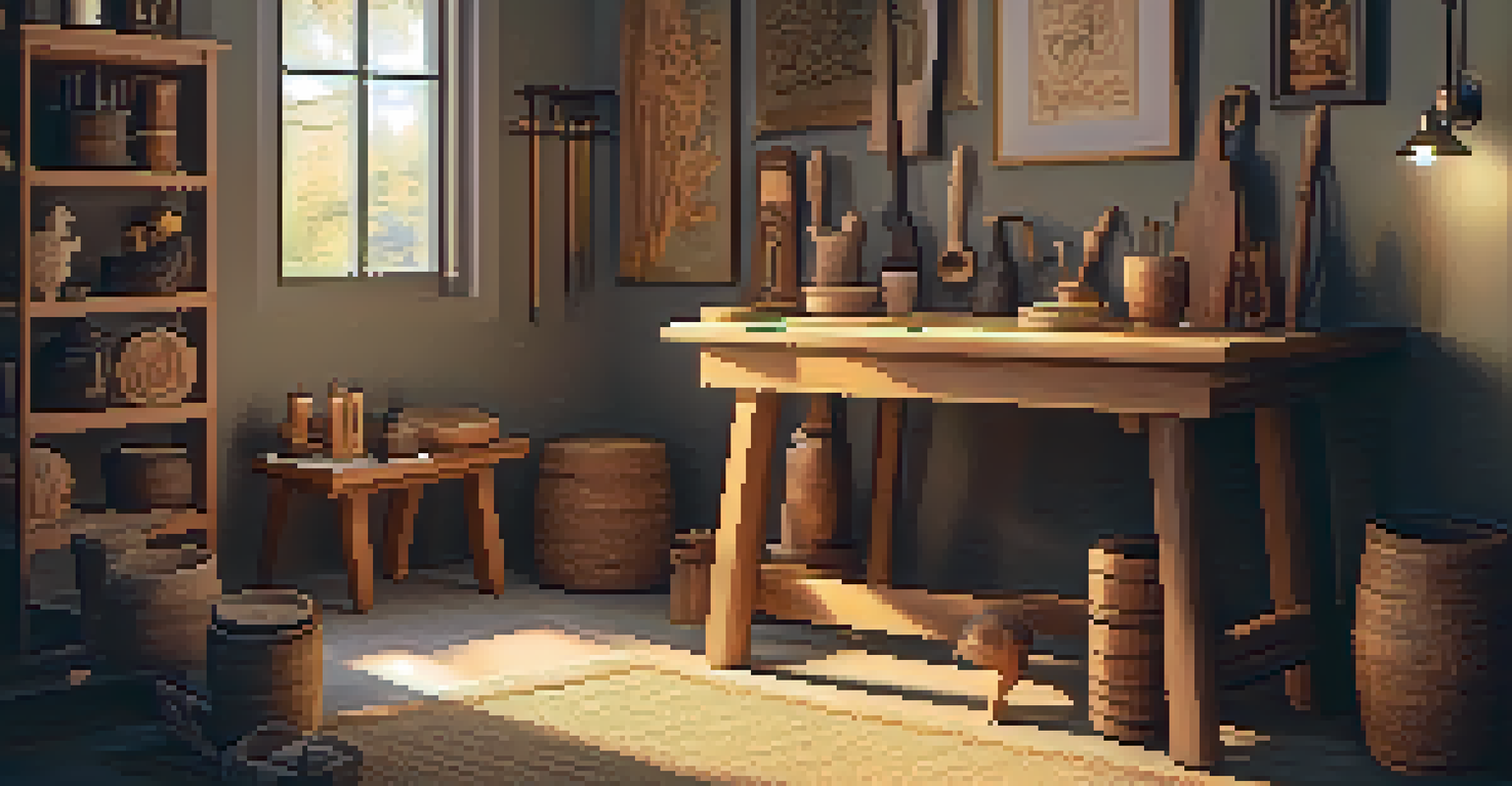Carving as a Meditative Practice: Finding Inner Peace

Understanding Carving as a Mindful Activity
Carving is more than just a craft; it’s a form of mindful expression. When you engage in carving, the repetitive motions and focused attention can create a sense of calm. This practice allows you to immerse yourself fully in the moment, much like meditation.
Art is not freedom from discipline, but disciplined freedom.
As you shape the material, whether wood, stone, or clay, your mind begins to quiet down. Each cut and stroke draws you deeper into concentration, pushing aside the distractions of daily life. This focus mirrors the stillness found in traditional meditation techniques.
By viewing carving as a mindful activity, you can transform simple tasks into powerful meditative moments. This shift in perspective not only enhances your skills but also nurtures your mental well-being, making every session an opportunity for personal growth.
The Therapeutic Benefits of Carving
Engaging in carving has numerous therapeutic benefits that can lead to inner peace. The act of creating something with your hands can be incredibly fulfilling, providing a sense of accomplishment. This fulfillment can help combat feelings of anxiety and stress, allowing for emotional release.

Moreover, the tactile nature of carving promotes mindfulness. As you feel the texture of the material and the weight of your tools, you become attuned to your senses. This sensory engagement fosters a connection to the present moment, much like mindfulness meditation.
Carving as Mindful Expression
Engaging in carving fosters a meditative state, allowing you to immerse yourself in the present moment and promote mental well-being.
Incorporating carving into your routine can serve as a therapeutic outlet. It offers a unique way to process emotions, channeling them into your art, thus promoting healing and self-discovery in the process.
How to Get Started with Carving
Starting your carving journey doesn’t require extensive experience or expensive tools. Begin with simple materials like softwood or clay, which are easier to manipulate. Just as with any new endeavor, the key is to embrace the learning process.
The act of creation is a form of mindfulness that allows you to connect with your inner self.
You might want to explore online tutorials or local workshops that can provide guidance and community support. These resources can help you learn basic techniques while connecting you with others who share your passion. Remember, it's about the experience rather than perfection.
As you carve, allow yourself to experiment and make mistakes. Each piece you create will teach you something new, and this journey of exploration can be incredibly fulfilling. Embrace the process, and you’ll find that carving becomes a joyful escape.
Creating a Dedicated Carving Space
Designing a dedicated space for carving can enhance your meditative practice. A clutter-free, organized area will allow you to focus without distractions. Consider including natural elements, like plants or stones, to create a calming atmosphere.
Lighting is another crucial factor; natural light can uplift your mood and creativity. If possible, set up your workspace near a window. If not, consider soft, warm lighting that mimics the sun's glow, encouraging a peaceful environment.
Therapeutic Benefits of Carving
The tactile experience of carving provides emotional release and serves as a unique outlet for processing feelings and self-discovery.
Additionally, surrounding yourself with inspirational items—like art, quotes, or photographs—can stimulate creativity. This personal touch not only makes your space inviting but also serves as a reminder of your journey toward inner peace through carving.
Making Carving a Regular Practice
To truly reap the benefits of carving as a meditative practice, consistency is key. Set aside dedicated time each week to engage with your craft. This regular commitment can help establish a routine that nurtures both your skills and your mental well-being.
You can start with short sessions, gradually increasing their length as you become more comfortable. Even 15-30 minutes can be transformative if approached with mindfulness. Over time, these moments will contribute to a deeper sense of calm and creativity.
Incorporating carving into your daily life may also inspire you to find peace in other areas. As you learn to focus and engage mindfully in your carving practice, you might notice similar benefits spilling over into your everyday activities.
Sharing Your Carving Journey
Sharing your carving journey with others can deepen your experience and build community. Consider joining local carving clubs or online forums where you can connect with fellow enthusiasts. These interactions can provide valuable feedback and encouragement.
Documenting your progress through photos or a journal can also be rewarding. Reflecting on your growth not only showcases your skills but also highlights the emotional journey you undertake with each piece. This personal narrative adds depth to your practice.
Building a Carving Routine
Establishing a regular carving practice enhances your skills and contributes to a deeper sense of calm and creativity in daily life.
You may even choose to exhibit your work, creating a space for dialogue about your experiences. Sharing the process and stories behind your creations fosters connection and inspires others to explore carving as a meditative practice.
The Lasting Impact of Carving on Inner Peace
The journey of carving as a meditative practice can lead to profound inner peace. Through the act of creating, you cultivate a sense of presence that enhances your mental clarity and emotional resilience. Each session offers a moment to reconnect with yourself and the world around you.
As you delve deeper into your carving practice, you may find that it becomes a vital aspect of your self-care routine. The patience and focus you develop while carving can extend to other facets of your life, making challenges feel more manageable.

Ultimately, carving is not just about the finished product; it’s about the journey of self-discovery and growth. Embracing this practice can transform your relationship with creativity, mindfulness, and, most importantly, yourself.